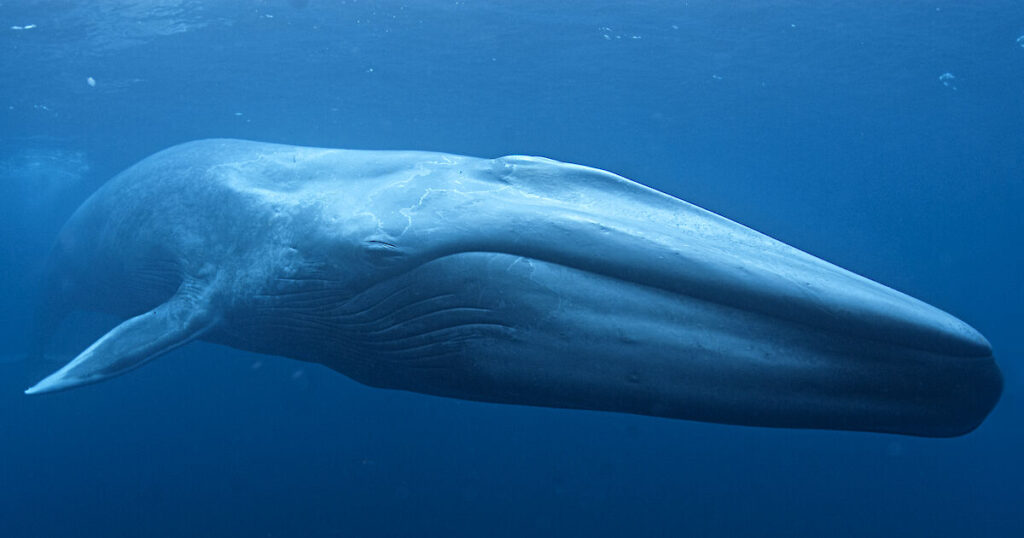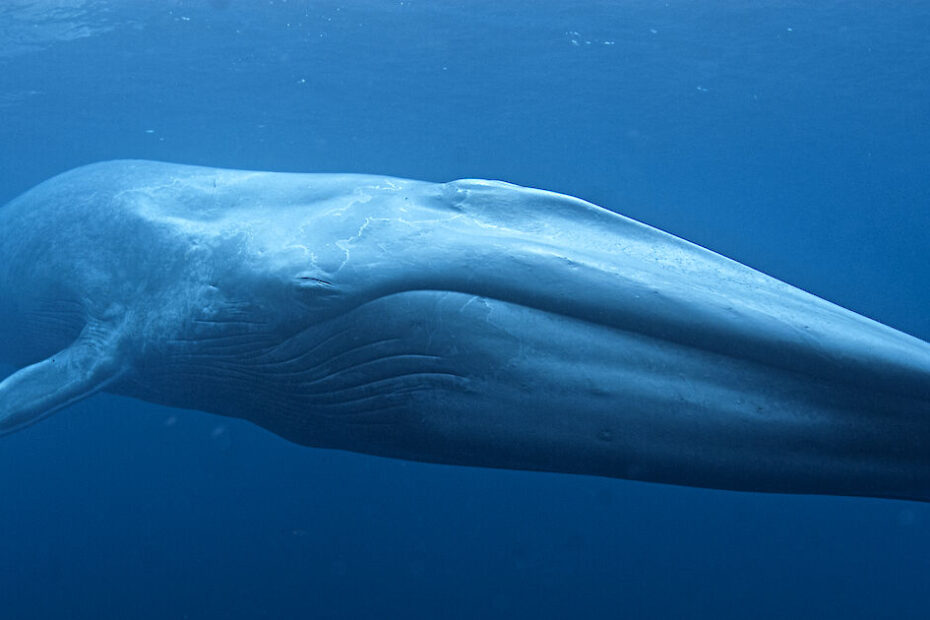In the vast and mysterious depths of the oceans, nature has crafted some of the most awe-inspiring creatures to have ever graced the Earth. These colossal beings, with their sheer size and extraordinary adaptations, have captured the imagination of scientists and enthusiasts alike. Join us on a fascinating journey as we explore the six biggest sea creature that ever existed, unveiling the secrets of the ocean’s most majestic giants.
1. Blue Whale: The Epitome of Oceanic Grandeur
The word “biggest sea creature” finds its quintessential representation in the colossal frame of the blue whale. As the largest animal on Earth, these gentle giants can reach lengths of up to 100 feet or more. The sheer enormity of the blue whale is underscored by its heart, the size of a small car, and its tongue, which alone can weigh as much as an elephant.
These marine leviathans traverse the oceans, filtering massive quantities of krill through their baleen plates. The sheer scale of the blue whale is a testament to the incredible adaptability and efficiency of nature in creating a creature of such immense proportions.
The Blue Whale (Balaenoptera musculus) is the largest animal on Earth and belongs to the baleen whale family. Known for its immense size, these majestic creatures can reach lengths of up to 100 feet (30 meters) and weigh as much as 200 tons. Blue Whales possess a distinctive blue-gray coloration with mottled skin and a relatively small dorsal fin.
These marine giants are found in oceans worldwide, typically favoring colder waters for feeding and warmer waters for breeding. Despite their enormous size, Blue Whales are filter feeders, primarily consuming small shrimp-like organisms known as krill. They employ a unique feeding method called “lunge feeding,” where they engulf large volumes of water and filter out the krill through their baleen plates.

Blue Whales are known for their hauntingly deep vocalizations, often referred to as songs, which play a crucial role in communication during breeding seasons. Sadly, these magnificent creatures face various threats, including collisions with large vessels, entanglement in fishing gear, and the impacts of climate change on their food sources. Conservation efforts are ongoing to protect and preserve these gentle giants, as their well-being is essential for maintaining the balance of marine ecosystem
2. Megalodon: The Ancient Apex Predator
When delving into the annals of prehistoric seas, the term “biggest sea creature” takes on a whole new dimension with the Megalodon. This colossal shark, the largest predator to have ever roamed the oceans, could reach lengths of up to 82 feet. Its formidable teeth, some exceeding 7 inches in length, reveal a predatory might that struck fear into the hearts of marine life during the Miocene and Pliocene epochs.
The Megalodon’s reign as the apex predator is a testament to its unparalleled size and power, making it a true giant of the ancient seas.
The Megalodon, meaning “big tooth,” was a prehistoric shark species that existed approximately 23 to 3.6 million years ago during the Cenozoic Era. Renowned as one of the largest and most powerful predators to have ever roamed the Earth’s oceans, the Megalodon’s size and capabilities have captured the imagination of scientists and the public alike.
With estimates suggesting lengths of up to 82 feet (25 meters) or more, the Megalodon dwarfed contemporary sharks, including the great white shark. Its iconic serrated teeth, some reaching over 7 inches (18 cm) in length, indicate a formidable carnivorous diet, likely consisting of marine mammals and large fish.
Despite its massive size, much about the Megalodon remains shrouded in mystery due to the limited fossil evidence available. Theories abound regarding its extinction, with factors such as changes in ocean temperature, prey availability, and competition with other predators all proposed as potential contributors.
While the Megalodon no longer patrols the seas, its legacy endures in popular culture through books, documentaries, and films that continue to depict this ancient giant as the ultimate maritime terror, solidifying its place as one of the ocean’s most legendary inhabitants.
3. Liopleurodon: The Jurassic Oceanic Behemoth
In the Mesozoic era, the Liopleurodon reigned supreme as one of the biggest sea creatures to navigate the oceans. This colossal marine reptile, with an estimated length of up to 82 feet, was a formidable apex predator. Its powerful jaws and sharp teeth allowed it to hunt and devour large prey, showcasing the evolutionary wonders that led to the development of such an imposing creature.
The legacy of the Liopleurodon stands as a testament to the diversity and grandeur of life in the ancient seas, where giants ruled the waves.
Liopleurodon is an extinct genus of large marine reptiles that lived during the Late Jurassic period, approximately 160 to 155 million years ago. Belonging to the Pliosauroidea superfamily, Liopleurodon was a formidable predator with a streamlined body and powerful flippers, indicating its adaptation to an aquatic lifestyle.
One of the most distinctive features of Liopleurodon was its massive size, with some estimates suggesting lengths of up to 23 feet (7 meters) or even larger. Its long, toothy snout housed sharp, conical teeth, which were well-suited for capturing and devouring a variety of prey, including fish and other marine creatures.
Liopleurodon is often popularized in popular culture, and its portrayal in documentaries and media has sometimes exaggerated its size and abilities. Despite this, it remains a fascinating and iconic representation of the diverse prehistoric marine life that once inhabited Earth’s oceans.
The fossils of Liopleurodon have been found in various locations, including England and France. Scientists continue to study these remains to gain a better understanding of its anatomy, behavior, and ecological role in the ancient seas. Although long extinct, Liopleurodon’s legacy lives on as a symbol of the awe-inspiring marine predators that once roamed the oceans of our planet.
4. Leedsichthys: The Gentle Giant of the Jurassic Waters
Not all giants of the sea were fearsome predators; some, like the Leedsichthys, were gentle filter feeders that traversed the oceans during the Jurassic period. This colossal fish, with an estimated length of up to 50 feet, relied on a specialized feeding mechanism to consume vast quantities of plankton and small marine organisms.
The Leedsichthys, with its colossal size and unique feeding strategy, represents a different facet of oceanic gigantism, emphasizing the diverse roles that such colossal creatures played in the ancient marine ecosystems.
Leedsichthys, a gigantic prehistoric fish, roamed the Earth’s oceans during the Jurassic period, approximately 150 million years ago. Belonging to the group of filter-feeding fish known as pachycormids, Leedsichthys holds the title of one of the largest fish to have ever existed. The name Leedsichthys is derived from the city of Leeds in England, where the first fossils of this colossal creature were discovered in the 19th century.
Estimated to reach lengths of up to 16 meters or more, Leedsichthys possessed a streamlined body, well-adapted for efficient swimming. Despite its enormous size, this fish was a filter feeder, sieving plankton and small organisms through its gill rakers to extract nutrients. Its jaw structure suggests that Leedsichthys could open its mouth wide to engulf large volumes of water and filter out the microscopic organisms.
While the exact lifestyle and behaviors of Leedsichthys remain speculative due to limited fossil evidence, its sheer size and unique adaptations contribute to our understanding of the diverse marine life that inhabited ancient oceans. Leedsichthys serves as a fascinating example of the incredible biodiversity that once flourished in Earth’s prehistoric seas.
5. Kronosaurus: The Terrifying Sea Monster of the Cretaceous
The Cretaceous period witnessed the dominance of yet another colossal sea creature, the Kronosaurus. With an estimated length of up to 30 feet, this pliosaur was a ferocious predator that patrolled the ancient oceans. Its massive skull, armed with sharp teeth, allowed it to hunt and devour large prey, showcasing the apex predator status it held during its time.
The Kronosaurus, with its formidable size and predatory prowess, exemplifies the dynamic and ever-changing nature of marine ecosystems throughout Earth’s history.
Kronosaurus is an extinct genus of marine reptile that lived during the Early Cretaceous period, approximately 120 million years ago. Belonging to the group of marine reptiles known as pliosaurs, Kronosaurus was an apex predator of the ancient seas. Fossils of Kronosaurus have been primarily found in Australia, particularly in Queensland.
Measuring up to 30 feet in length, Kronosaurus possessed a robust and streamlined body with powerful flippers, indicating its adaptation for an aquatic lifestyle. Its most distinctive feature was its large head, equipped with sharp, conical teeth, suggesting a carnivorous diet. The name “Kronosaurus” is derived from the Greek titan Kronos, reflecting the creature’s formidable and dominant nature.
As a top predator, Kronosaurus likely preyed on various marine animals, including fish, squids, and other marine reptiles. Its well-developed limbs and tail suggest that it was a strong and agile swimmer, capable of navigating the open ocean with ease. The discovery of Kronosaurus fossils has contributed significantly to our understanding of prehistoric marine ecosystems, shedding light on the diverse array of life that existed in Earth’s ancient seas.
6. Elasmosaurus: The Long-Necked Titan of the Cretaceous Seas
In the Cretaceous seas, the Elasmosaurus stood out as one of the longest-necked and largest marine reptiles to have ever existed. With an estimated length of up to 46 feet, this plesiosaur’s distinctive feature was its remarkably long neck, which it used to hunt and capture prey with precision.
The Elasmosaurus, with its elongated neck and colossal size, represents a fascinating example of the evolutionary adaptations that allowed certain sea creatures to thrive in diverse ecological niches during prehistoric times.
Elasmosaurus, a prehistoric marine reptile, lived during the Late Cretaceous period, around 80 million years ago. Belonging to the group of long-necked plesiosaurs, it was a remarkable creature with a distinctive appearance. Elasmosaurus measured up to 46 feet in length, with an elongated neck comprising about two-thirds of its total body length, which set it apart from other marine reptiles of its time.
Characterized by a streamlined body and paddle-like limbs, Elasmosaurus was well-adapted for a marine lifestyle. Its long neck, however, presented challenges in terms of buoyancy and maneuverability, leading scientists to speculate about its swimming habits and feeding strategies. It likely used its neck to reach prey efficiently, perhaps targeting small fish and cephalopods.
Fossil discoveries of Elasmosaurus have primarily been in North America, particularly in regions that were once covered by the Western Interior Seaway. The first complete skeleton was found in Kansas in the 19th century, contributing significantly to our understanding of marine life during the Cretaceous period.
Despite its extinction along with other dinosaurs and marine reptiles, Elasmosaurus continues to captivate the imagination of paleontologists and enthusiasts, providing valuable insights into the diverse ecosystems that existed millions of years ago.
In the depths of the Earth’s oceans, the term “biggest sea creature” transcends mere size; it encapsulates the grandeur, diversity, and evolutionary marvels that have shaped the history of marine life. From the colossal blue whale to the ancient apex predator Megalodon, and the long-necked titan Elasmosaurus, these giants of the sea have left an indelible mark on the tapestry of life on Earth. As we continue to explore and understand the secrets of the oceans, the allure of these majestic creatures serves as a constant reminder of the wonders that lie beneath the surface of our planet’s vast and mysterious waters.
Featured image courtesy: https://www.antarctica.gov.au/about-antarctica/animals/whales/blue-whale/
